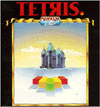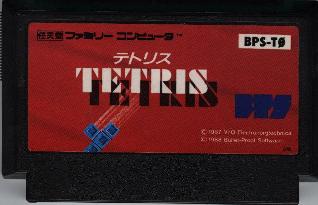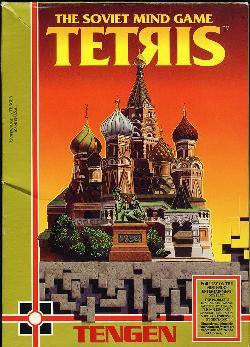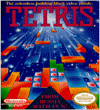 Tetris is one of the few games that achieves ultimate popularity. It is remarkably simple, yet remarkably difficult. It's been ported to every computer and game console known to man, and has sold millions of cartridges, tapes, and disks across the land. Besides that, it also led to one of the most interesting legal battles in the history of video games, leading to the famed Tengen version of Tetris and to the downfall of a few companies. It's a pretty cool story, so let's get down to business. Hold on for a second while I set the time machine to cruise control.. June 1985 July 1986 November 1986
Meanwhile, the IBM PC version of Tetris is released by Spectrum Holobyte and Mirrorsoft, causing an instant sensation not only as an obscenely addictive game, but also as "the first game from behind the iron curtain". The game is filled with graphics of Russian themes (battles, Matthias Rust landing his Cessna on Red Square, Yuri Gagarin's first space mission). Stein still does not legally own any rights to Tetris. June 1987 January 1988 ELORG's director, Alexander Alexinko, realizes that Stein is giving out rights he doesn't have and threatens to cut off any deal. Stein, in turn, threatens to start an international situation. May 1988 July 1988 Robert Maxwell, owner of both Mirrorsoft and Spectrum, sides with Mirrorsoft on the matter. Atari starts plans to release an arcade and NES game (under the Tengen label). Bullet-Proof Software still has the computer rights in Japan; BPS president Henk Rogers successfully gets the rights to release a video-game version later in the year. Tetris is released for the Famicom in early November 1988; eventually, two million cartridges would be sold.
November 1988 February 21, 1989 A reminder: Robert Stein's original agreement was only for computer versions of Tetris. Any other rights he gave out weren't his to sell. Later, Stein makes it to ELORG. Belikov makes him sign an alteration to the original contract defining computers as "PC computers which consist of a processor, monitor, disk drive(s), keyboard and operation system". Stein misses this line defining computers; he later realizes that it was all a big orchestration on Rogers' part to get his rights from Stein. The next day, he is told that, although he can't get the handheld rights at the moment, he can get the arcade-game rights. He signs the contract for them three days later. February 22, 1989 The final scorecard: Kevin Maxwell walks off with a piece of paper, Robert Stein with the arcade rights, and ELORG with conclusive evidence, thanks to Maxwell's assertion that any Famicom carts are pirates, that it never sold the video game rights. If Maxwell wanted those rights it would have to outbid Nintendo. Henk Rogers has the handheld rights and tells Arakawa at NOA that the console rights are up for grabs. BPS makes a deal to let Nintendo make Tetris for Game Boy; a deal that was ultimately worth between $5 and 10 million to BPS. March 15, 1989 March 22, 1989 March 31, 1989 April 13, 1989 Robert Maxwell, meanwhile, is using his vast media empire to try to get Tetris back. He contacts both the Soviet and British governments to intervene on the Tetris matter. Infighting between the Communist party and ELORG begins, and Maxwell gets a promise from no less than Mikhail Gorbachev that he "should no longer worry about the Japanese company". In late April, Lincoln flies back to Moscow and learns of ELORG's being put upon by the government. In the middle of the night, he receives a call from NOA that Tengen has sued Nintendo. The next day, he starts interviewing Belikov, Pazhitnov, and many others at ELORG, to make sure that Nintendo's case for the Tetris home rights is airtight. NOA immediately countersues Tengen, and evidence begins to be gathered. May 17, 1989
June 1989 The battle mostly hinged on one matter: Was the Nintendo Entertainment System a computer, under the definition in the contract that Belikov made Stein sign, or a video-game system? Atari argued that the NES was meant to be a computer, due to its expansion port and the existence of a computer network for the Famicom (short for "Family Computer") in Japan. Nintendo's argument was more to the point: the Russians at ELORG had never had the intention of selling the video game rights to Tetris; the definition of "computer" in Stein's contract proved it. June 15, 1989 June 21, 1989 July 1989 This ends the main history of Tetris; the lawsuit between Nintendo and Atari would continue to drag on and on and on (it was finally finished up by 1993).
Epilogue Atari Games still released an arcade version of Tetris, selling about twenty thousand units. Atari Games was recently bought up by Williams/WMS; the fate of the Tengen Tetris carts lying in warehouses is unknown. In all likelihood they were bulldozed since Tengen could not legally get rid of them any other way. If the figures are to be believed, there are about one hundred thousand Tengen Tetris cartridges floating around; a less-than-average run by NES standards, but still nowhere near an impossible cart to find. Robert Stein made, in total, about $250,000 on Tetris. He could have made a great deal more, of course, but Stein had trouble getting Atari and Mirrorsoft to pay him royalties for the (bogus) rights he sold them. Spectrum Holobyte had to organize another deal with ELORG just to hold on to the computer rights to Tetris. Robert Maxwell's large-scale media organization collapsed in the midst of the struggle, and Robert Maxwell himself died suspiciously as questions rose about whether he was entirely honest about his business dealings. As a result, Mirrorsoft UK faded away as well. The big winners of the whole affair were Henk Rogers, president of BPS, and Nintendo themselves. How much did Tetris make for Nintendo? That's difficult to answer, considering that Tetris being the pack-in for the Game Boy enticed customers to buy the Game Boy.. and from there, buy other Game Boy carts. Bringing all this into account, the figure can go up and up and up. About 30 million Game Boy Tetris carts have been made. As for the Russians, no one made big money from Tetris except for the Soviet government. As the USSR broke up, the people at ELORG and the Academy scattered across the country. Alexey Pazhitnov made nearly no money from Tetris itself. ELORG made, then cancelled a deal that would have given him merchandising rights to Tetris. Still, Pazhitnov was happy that the game he created became famous world-wide, and he did get an 286-clone from the Academy as a reward; he also had a much nicer apartment than most of his colleagues. In 1996, with the financial backing of Henk Rogers, he organized The Tetris Company LLC, and is now finally getting royalties for his creation.
|




